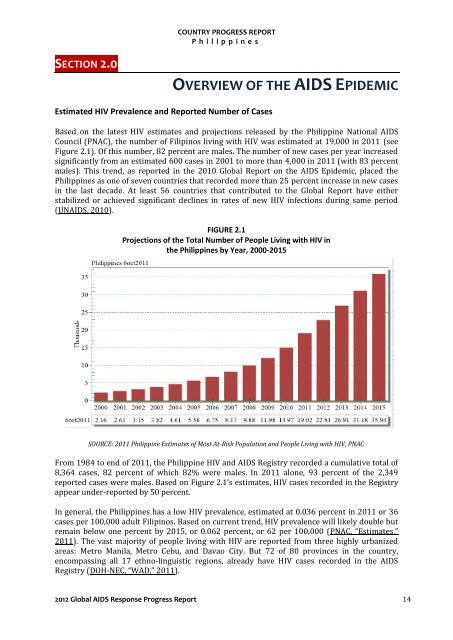Download this publication - HIV/AIDS Data Hub
Download this publication - HIV/AIDS Data Hub
Download this publication - HIV/AIDS Data Hub
You also want an ePaper? Increase the reach of your titles
YUMPU automatically turns print PDFs into web optimized ePapers that Google loves.
COUNTRY PROGRESS REPORTP h i l i p p i n e sSECTION 2.0OVERVIEW OF THE <strong>AIDS</strong> EPIDEMICEstimated <strong>HIV</strong> Prevalence and Reported Number of CasesBased on the latest <strong>HIV</strong> estimates and projections released by the Philippine National <strong>AIDS</strong>Council (PNAC), the number of Filipinos living with <strong>HIV</strong> was estimated at 19,000 in 2011 (seeFigure 2.1). Of <strong>this</strong> number, 82 percent are males. The number of new cases per year increasedsignificantly from an estimated 600 cases in 2001 to more than 4,000 in 2011 (with 83 percentmales). This trend, as reported in the 2010 Global Report on the <strong>AIDS</strong> Epidemic, placed thePhilippines as one of seven countries that recorded more than 25 percent increase in new casesin the last decade. At least 56 countries that contributed to the Global Report have eitherstabilized or achieved significant declines in rates of new <strong>HIV</strong> infections during same period(UN<strong>AIDS</strong>, 2010).FIGURE 2.1Projections of the Total Number of People Living with <strong>HIV</strong> inthe Philippines by Year, 2000-2015SOURCE: 2011 Philippine Estimates of Most At-Risk Population and People Living with <strong>HIV</strong>, PNACFrom 1984 to end of 2011, the Philippine <strong>HIV</strong> and <strong>AIDS</strong> Registry recorded a cumulative total of8,364 cases, 82 percent of which 82% were males. In 2011 alone, 93 percent of the 2,349reported cases were males. Based on Figure 2.1’s estimates, <strong>HIV</strong> cases recorded in the Registryappear under-reported by 50 percent.In general, the Philippines has a low <strong>HIV</strong> prevalence, estimated at 0.036 percent in 2011 or 36cases per 100,000 adult Filipinos. Based on current trend, <strong>HIV</strong> prevalence will likely double butremain below one percent by 2015, or 0.062 percent, or 62 per 100,000 (PNAC, “Estimates,”2011). The vast majority of people living with <strong>HIV</strong> are reported from three highly urbanizedareas: Metro Manila, Metro Cebu, and Davao City. But 72 of 80 provinces in the country,encompassing all 17 ethno-linguistic regions, already have <strong>HIV</strong> cases recorded in the <strong>AIDS</strong>Registry (DOH-NEC, “WAD,” 2011).2012 Global <strong>AIDS</strong> Response Progress Report 14















